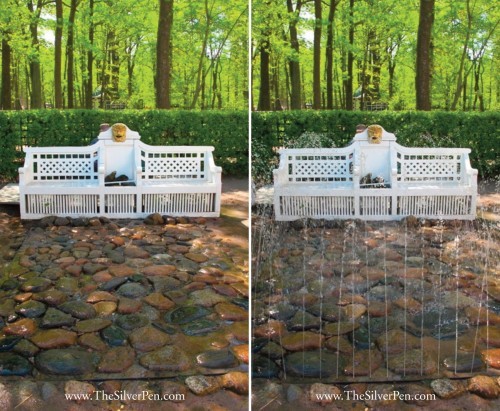Perhaps two of my favorite parts of our amazing and extraordinary and magical trip to Russia were the time spent at Peterhof Palace and the Hermitage. Truly beyond belief. And stunning. Did I say magical? Ahhhh, yes.
Peterhof Palace (or Petrodvorets in Russian) is nicknamed the “Russian Versailles” because it resembles…yes, the French Versailles. Peterhof is comprised of several different areas and buildings including the Grand Peterhof Palace, the Upper Gardens, the Lower Gardens, along with several pavilions and museums. The Palace is the main attraction and started as a small mansion built for Peter the Great. You may remember from the last post that he was rather low key, though as I also said in the last post, everything in Russia is relative!
The Grand Peterhof Palace sits on the shores of the Gulf of Finland atop a beautiful bluff. Since the time of Peter up until the early 20th century it was the official summer palace (Peter called it his “Seaside Paradise”) of the Russian Tsars. During the reign of Elizabeth, Bartolomeo Rastrelli added to the Palace in his unique Baroque style…and when I say Baroque, think: G.O.L.D.
The Grand Cascade (below) is the most notable and ornately designed of all the fountains in Peterhof. Its design was conceived by Peter I and construction began in 1716 and was finished on July 13, 1721. The fountains were severely damaged during World War II (you can’t BELIEVE what the Nazi’s did to the Russian Palaces!) and had to be restored from photos. The restoration was painstakingly difficult and took many years, even as recently as 1995 there were restoration projects taking place but today it is fully restored…and magnificent.
Peterhof has a unique fountain system that requires no pumps (which is seriously COOL and AMAZING). Water for the fountains is supplied by a gravity-fed water system, creatively designed to use the natural slope of the terrain. This pump-less system supplies enough water to the fountains and cascades of Peterhoff to keep them working for up to ten hours a day.
Peter the Great had a sense of humor. He liked playing jokes on his guests by showing them ‘trick’ fountains. They are FABULOUS…no water one minute and the next, water everywhere, soaking everyone around. The musical staccato fountains still shoot up at unpredictable intervals and children drench themselves in warm weather while trying to guess which one will go off next. It’s SO FUN! I did learn the trick(s) while there, but I won’t tell….!
Bizarre, I know…but I couldn’t NOT include it, now could I?
Back in St. Petersburg proper, we spent time at the over-the-top Hermitage (a/k/a The State Hermitage Museum). Geez-Louise, was it AMAZING! I know that I keep using intense adjectives, but that’s because these places are all that and MORE!
The collection of the Hermitage includes more than three million works of art and artifacts of the world culture. Among them are paintings, graphic works, sculptures and works of applied art, archaeological finds and numismatic material. Not only is the art divine, but the interiors are pretty drool-inducing themselves!
The collection of Catherine the Great began in her Winter Palace with the purchase of more than 200 paintings from Berlin art merchant Johann Ernst Gotzkowsky. This collection consisted of a plethora of impressive works by artists such as Rembrandt, Rubens, Van Dyck, Raphael, Holbein, and gobs of others others.
Extensions were continuously built to Catherine’s Winter Palace in order to accommodate her growing collection of works of art. Initially the collection was housed in the Winter Palace, but in 1771-1787 Catherine had the Small Hermitage built to showcase her collection.
Soon, the Great Hermitage (1771-1787) was added to the east of the Small Hermitage and finally the New Hermitage was built in 1839-1851. In 1852 the New and Great Hermitage were opened to the public by tsar Nicholas I. After the Russian Revolution in 1917 the Winter Palace was added to the Hermitage Museum. After the Second World War, the museum has continued to expand, adding not only to its collection but also adding more buildings to the museum complex.
Historians say that during her lifetime Catherine the Great acquired 4,000 paintings by the “Old Masters”, 38,000 books, 10,000 engraved gems, 10,000 drawings, 16,000 coins and medals and a natural history collection filling two galleries. By amassing this large collection, Catherine the Great aimed to enhance the international reputation of the Russian imperial court. At the same time, it was a display of power and wealth, sending an important political symbol to rival empires in Europe.
If you ever, ever, ever have the opportunity to go to Russia, please goooooooo!
In the meantime, thank you all for coming on this Silver Lined adventure with me!
Bon weekend!
All images taken by Hollye Jacobs for The Silver Pen.














Oh Oh Oh Oh Oh… yesterday's and today's so wonderful and like being there with you – and so much good info. I have been but has been ages – okay it was still Leningrad then – and now you've so made me want to go back. Your Silver Pen is the next best thing in the meantime. Oh (again) and official congratulations for being named on of the Forbes Top 100!!!!!! No blog more deserving. xox
I wish you had been, Frances! Thanks for your sweet note. I really appreciate it! xxx
Hollye,
You definitely captured the beauty of St. Petersburg. Thanks for sharing your photos and experiences from this wonderful trip.
Pete
Thanks a million, Pete! I really appreciate it!
Thank you for letting us be part of your travel to Russia, how beautiful, just amazing.
Thank you for joining me, Ingrid! It means so much to me!